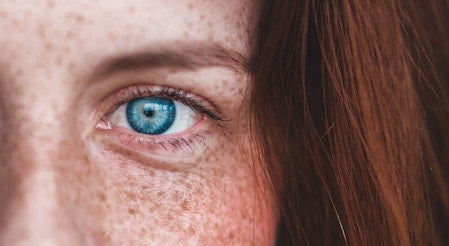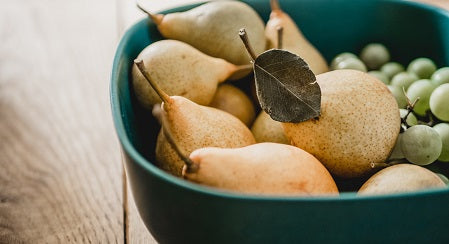
Nos actifs 12/04/2023
L’Astaxanthine : Reine des antioxydants anti-âge
Astaxanthine, nom quelque peu imprononçable, est une merveille anti-âge 100% naturelle. Extraite de la micro-algue Haematococcus pluvialis, l'astaxanthine est réputée pour ses propriétés antioxydantes et spécifiquement pour la protection et la santé de la peau, des yeux et du cerveau. Découvrez-en plus sur cette reine des antioxydants.
Astaxanthine : présentation
L'astaxanthine est un pigment rouge vif appartenant à la famille des caroténoïdes, précisément des caroténoïdes xanthophylles. Peu présent dans l’alimentation, on peut toutefois en retrouver dans le krill, les crustacés ou le saumon mais sa source naturelle la plus concentrée est la micro-algue Haematococcus pluvialis, raison pour laquelle elle en est généralement extraite pour composer les compléments alimentaires.
Autre spécificité, grâce à une structure moléculaire contenant un groupe céto et un groupe hydroxyle à chaque extrémité, l'astaxanthine présente des caractéristiques uniques qui soutiennent son utilisation dans la promotion de la santé humaine [4].
A l’état naturel, le rôle de ce pigment est de protéger des radiations UV et du stress. C’est donc un antioxydant particulièrement reconnu pour la peau et les yeux dans le cadre de la protection liée au rayonnement UV du soleil. Sa capacité antioxydante très élevée permettrait de limiter l’impact et les dégâts sur le derme, de préserver des coups de soleil et de limiter les signes du vieillissement cutané.
Si l’astaxanthine semble être une fabuleuse alliée face aux méfaits du soleil, c’est également une molécule anti-âge pour nombres d’autres systèmes de notre organisme notamment la vision, le cerveau et la peau.
L'Astaxanthine : puissant antioxydant
On dit de l’astaxanthine que c’est un puissant antioxydant, mais qu’est-ce qu’un antioxydant et à quoi ça sert ?
Un antioxydant, mot très tendance dans le monde de la cosmétique, de la santé et surtout de l’anti-âge, est une molécule qui agit contre l’oxydation de nos cellules due aux radicaux libres. Si ces radicaux libres sont en trop grand nombre, l’organisme n’arrive plus à les combattre et passe dans un état dit de stress oxydatif, état qui accélère le vieillissement du corps et la dégénérescence cellulaire.
L’astaxanthine est réputée pour son action antioxydante qui semble être largement supérieure aux autres caroténoïdes. Elle est d’ailleurs estimée à 20x supérieure à celle du bêta-carotène [1]. Cette supériorité serait due à sa structure moléculaire unique : l’astaxanthine contient à chaque extrémité de sa molécule des groupes polaires qui luttent contre les radicaux libres et, à son segment central, des doubles liaisons qui réduisent les électrons nocifs [5].
Aussi, l’astaxanthine est aussi considérée comme l’un des plus puissants antioxydants, car elle serait capable d’atteindre l’intérieur et l’extérieur des cellules, ce qui permettrait de protéger la totalité de la cellule contre les radicaux libres.
Finalement, c’est un antioxydant qui a la particularité de ne pas devenir pro-oxydante, contrairement à de nombreux antioxydants qui se convertissent dans le corps humain en vitamine A (rétinol), dont l’excès est dangereux.
L’Astaxanthine : protection du cerveau
Parmi les organes et systèmes qui déclinent avec l’âge, et qui nous préoccupent, il y a le cerveau et les fonctions cognitives.
L’astaxanthine semble agir sur les fonctions cognitives en prévenant ou retardant certaines pathologies neurodégénératives. C’est notamment le cas du déclin cognitif et de la démence, où l’inflammation et le stress oxydatif sont pointés du doigt par de nombreuses études [6]. Par ailleurs, plusieurs recherches ont évalué l’impact de l’astaxanthine sur ces fonctions par des essais randomisés en double aveugle [1]. Une étude portant sur des personnes entre 45 et 64 ans se plaignant d’oubli, a démontré qu’avec une dose journalière de 12mg, les résultats de tests cognitifs et l’apprentissage de labyrinthe se sont améliorés [1]. Une autre étude met en évidence, chez des personnes entre 45 et 64 ans sans trouble cognitif, qu’une dose de 8mg/jour améliore significativement le rappel des mots par rapport au groupe placebo [1].
Il semble ainsi que l’astaxanthine contribue à protéger le cerveau par sa forte activité antioxydante et anti-inflammatoire [1, 2] et préviendrait les déficits de la mémoire. Également, elle induirait la prolifération des cellules progénitrices neurales et favoriserait la neurogenèse et la neuroplasticité[7] qui diminuent avec l'âge.
L’Astaxanthine : santé des yeux et de la vision
Une autre préoccupation qui vient avec l’âge est la vision.
L’astaxanthine semble aussi être protectrice de la santé de yeux, car elle est réputée prévenir la fatigue oculaire, la sécheresse, la sensibilité au soleil mais aussi la dégénération maculaire liée à l’âge (DMLA) et la cataracte [1, 2, 7]. Ces effets préventifs pourraient être liés à son rôle protecteur du cristallin [8] ainsi qu’à ses propriétés antioxydantes qui neutraliseraient l’oxygène singulet et protégeraient des lésions photochimiques [2].
Des études sur les animaux ont également montré que l'astaxanthine aide à protéger contre la photokératite, la formation de cataractes et les lésions rétiniennes associées à une augmentation de la pression intraoculaire [1].
L’Astaxanthine : alliée de la peau
Quand on parle d’effets anti-âges, on pense souvent aux aspects qui touchent la beauté, l’esthétique et surtout la peau et les rides. Là encore, l’astaxanthine se distingue comme une alliée pour une peau en bonne santé, protégée, sublimée et éclatante.
Protection solaire, anti-inflammatoire, réparatrice ou encore hydratation et collagène : explications des actions anti-âge pour la peau :
Protection face aux méfaits du soleil
Populaire depuis quelques années, fréquemment démontré par la science moderne [1, 2, 3, 9], l’astaxanthine aurait des propriétés protectrices contre les dommages et le vieillissement causés par les UV et les coups de soleil.
L’astaxanthine, comme d’autres caroténoïdes, a la particularité d’avoir une structure moléculaire composée d’au moins dix doubles liaisons conjuguées, ce qui offre un potentiel élevé de piégeages des espèces réactives à l’oxygène (ROS), agissant en partie comme protection contre l’irradiation des UV [2]. En partie, car elle ne remplace pas une protection UV et une crème solaire reste indispensable.
L’astaxanthine permet de préparer la peau et de mieux supporter les expositions au soleil par le biais de plusieurs actions :
- Prévenir le photo-vieillissement cutané
- Combattre le stress oxydatif engendré par les UV
- Prévenir les érythèmes solaires – les fameux « coups de soleil »
- Renforcer la pigmentation de la peau
- Améliorer la tolérance au soleil et prévenir les lucites – allergies au soleil qui touchent particulièrement les femmes
- Apporter une protection complémentaire aux tissus de la peau et des yeux qui sont en contact direct avec la lumière
Elle favorise également le bronzage, car elle a la propriété de stimuler la production de mélanine, le pigment qui colore la peau.
Pour plus d’information sur l’action de l’astaxanthine contre le soleil, consultez notre article.
Soutien anti-inflammatoire
Rougeurs et sensibilité sont fréquemment le résultat d’une inflammation chronique de la peau, due à un stress oxydatif continu [4]. L’astaxanthine peut fonctionner comme un inhibiteur des effets inflammatoires du rayonnement UV en diminuant la production d'espèces réactives de l'azote, l'expression des cytokines inflammatoires et l'apoptose (mort cellulaire) dans l'épiderme [9]. Ainsi, elle peut soulager ces symptômes inflammatoires [3, 9], mais aussi, elle a longuement été étudiées dans le développement de traitements contre le psoriasis et la dermatite atopique [4].
Réparation de la peau
En vieillissant, nous sommes plus sensible au photo-vieillissement qui peut entraîner une production plus importante de ROS (espèces réactives de l'oxygène). Ces ROS peuvent stimuler la synthèse des MMP (métalloprotéinases matricielles) qui sont responsables de la dégradation de la matrice extracellulaire et du collagène, avec pour résultat une peau plus fine, plus fragile et un taux d'épithélialisation plus lent [3].
Étudié depuis une dizaine d’années dans les questions de réparation et de cicatrisation de la peau, l'astaxanthine semble réduire les dommages cellulaires causés par les radicaux libres et les MMP, augmenter l’épaisseur du derme et contribuer à améliorer la cicatrisation des plaies [1, 3].
Anti-vieillissement cutané
“Last but not least”, l’astaxanthine contribue à maintenir la bonne santé de la peau, à la sublimer et à prévenir son vieillissement cutané.
L’astaxanthine stimule l’hydratation, la tonicité, l’élasticité de la peau ainsi que la production de collagène [3, 10]. Par ces effets anti-âges, elle prévient l’apparition de rides, l'hyperpigmentation et les tâches solaires ou de vieillesse [1, 3], symbole du vieillissement cutané.
Plusieurs études appuient ces résultats :
- Une étude clinique humaine a démontré qu’une prise oral d’astaxanthine sur 8 semaines avait des effets sur les rides cutanées (pattes d'oie), la taille des taches de vieillesse, l'élasticité, la texture et l'hydratation de la peau [10].
- Une étude réalisée en 2020 démontre que l'astaxanthine augmente l'hydratation du derme en renforçant l'activité de l'aquaporine-3 (AQP3), un canal d'eau jouant un rôle dans l'hydratation de la peau [11].
- Plusieurs études démontrent qu’une dose d’astaxanthine entre 6 et 12 mg/jour peut augmenter l’élasticité de la peau et son taux d’hydratation, mais aussi améliorer la texture de la peau [1].
Puissante action antioxydante, protection du cerveau, santé des yeux et alliée de la peau : l’astaxanthine est une véritable alliée anti-âge pour préserver la jeunesse de son organisme.
Sources
[1] Ash, Michael. "Astaxanthin: The Key to a New You."
[3] "Astaxanthin: The antioxidant queen of skin care."
[4] Davinelli, S., Nielsen, M. E., & Scapagnini, G. "Astaxanthin in Skin Health, Repair, and Disease: A Comprehensive Review. " Nutrients. 10(4) (2018): 522.
[5] Higuera-Ciapara, I., Félix-Valenzuela, L., & Goycoolea, F. M. "Astaxanthin: a review of its chemistry and applications. " Critical reviews in food science and nutrition. 46(2) (2006): 185–196.
[6] Padurariu M, et al. "The oxidative stress hypothesis in Alzheimer’s disease. " Psychiatr Danub. 25(4) (2013): 401-9.
[7] Grimmig B, et al. "Neuroprotective mechanisms of astaxanthin: a potential therapeutic role in preserving cognitive function in age and neurodegeneration. " Geroscience. 39(1) (2017): 19-32.
[8] Yang, M., Chen, Y., Zhao, T., & Wang, Z. "Effect of astaxanthin on metabolic cataract in rats with type 1 diabetes mellitus." Experimental and Molecular Pathology, 113 (2020).
[9] Yoshihisa, Y., Rehman, M. U., & Shimizu, T. "Astaxanthin, a xanthophyll carotenoid, inhibits ultraviolet-induced apoptosis in keratinocytes." Experimental dermatology, 23(3). (2014): 178–183.
[10] Tominaga, K., Hongo, N., Karato, M., & Yamashita, E. "Cosmetic benefits of astaxanthin on humans subjects." Acta biochimica Polonica. 59(1) (2012): 43–47.
[11] Ikarashi, N., Kon, R., Nagoya, C., Ishikura, A., Sugiyama, Y., Takahashi, J., & Sugiyama, K. "Effect of Astaxanthin on the Expression and Activity of Aquaporin-3 in Skin in an In-Vitro Study." Life (Basel, Switzerland), 10(9) (2020).


